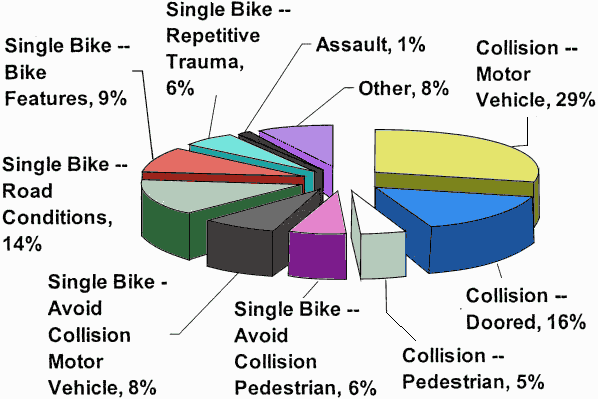JOHN S. ALLEN'S BICYCLE FACILITIES, LAWS AND PROGRAMS PAGES |
||
 |
Top: Home Page Up: Bicycle facilities Next: Fred Meredith comments |
 |
JOHN S. ALLEN'S BICYCLE FACILITIES, LAWS AND PROGRAMS PAGES |
||
 |
Top: Home Page Up: Bicycle facilities Next: Fred Meredith comments |
 |
by John S. Allen
This article examines the issue of bicyclists' car-door collisions by reviewing
studies which have addressed this issue. Of importance, the rate of car-door collisions is
shown to be much higher in studies of urban areas with parallel parking than in the
oft-cited 1977 national Cross-Fisher study.Studies circa 1980The 1984 Metropolitan Area Planning Council study of the Boston area gave considerable attention to the car-door collision problem. Car-door collisions are called "Class G" in the MAPC study. For the Boston area,
The report of the Boston study also includes results from a Missoula, Montana study. Kenneth Cross's report for the American Automobile Association, published as a follow-up to the Cross-Fisher study, provides information from another, unreported study of car-bike collisions by Cross, which shows a rate of 6.4% in Washington, DC and an overall rate of 2.6%. Cross's earlier, 1974 study of collisions in southern Santa Barbara county, California showed a rate of 7.29%. Other, more recent studiesOther, more recent studies confirm the importance of dooring collisions in cities with on-street parking:
|
Events leading to injury,
from Dennerlein-Meeker study of Boston-area bicycle couriers

|
CommentsThe rate of dooring collisions has increased over the years, reaching 30% of self-reported crashes by Boston bicycle couriers in 2002, and 30% of crashes resulting in an emergency call (to police or for an ambulance) on an arterial with bike lanes the door zone of parked motor vehicles in Boston in 2012. The number of crashes recorded in the 1974 Santa Barbara study is 128 per year over the three-year period 1971-1973. The number recorded in the newer Santa Barbara study is 77 for the year 1995, but in a smaller sample area. The Santa Barbara study indicates that most bike lanes were installed after the preparation of a bicycle plan in 1974. This comparison suggests that bike lanes adjacent to parking may increase the rate of dooring collisions, though the absence of bicycle use figures and the small sample size in the newer study make a more definitive statement impossible. A shared use arrow "sharrow" marking has been advanced as an alternative to bike lane striping which may reduce this problem; a research study has shown it to promote cyclists' riding farther form parked cars. See document from the US Federal Highway Administration. At the time the Boston courier study was conducted, there was only one short bike lane in Boston, and it was outside the downtown area. Bike lanes were common in neighboring Cambridge, but Cambridge is much less heavily served by the bicycle couriers than downtown Boston. Factors which account for the couriers' high rate of dooring appear to include a lack of training; the incentive to take risks to increase speed of deliveries; and couriers' relatively high speed due to fitness from daily riding. Almost all streets in the Boston downtown areas heavily served by the couriers have parallel parking. The low rate of car-door collisions in Austin compared with that in Santa Barbara is also interesting. Cyclist and journalist Fred Meredith has described conditions in Austin and in Santa Barbara but does not have a definitive explanation (see messages from Meredith). All of the studies from urban areas with parallel parking show a far greater rate of car-door collisions than the 0.8% in the national Cross-Fisher study, conducted in the mid-1970s. The Cross-Fisher study examined crashes on all types of roadways, rural, suburban and urban, with and without parallel parking, diluting the results for streets with parallel parking. It is reasonable to assume that bicyclists tend to avoid streets with traffic congestion and parallel parking when they can, further diluting the results. Another analysis of bike lanes adjacent to parking has been posted by Wayne Pein. Thanks to Paul Schimek for contributions to this page. |
| Top: Home Page Up: Bicycle facilities Next: Fred Meredith comments |
Contents © 2002, John S. Allen |